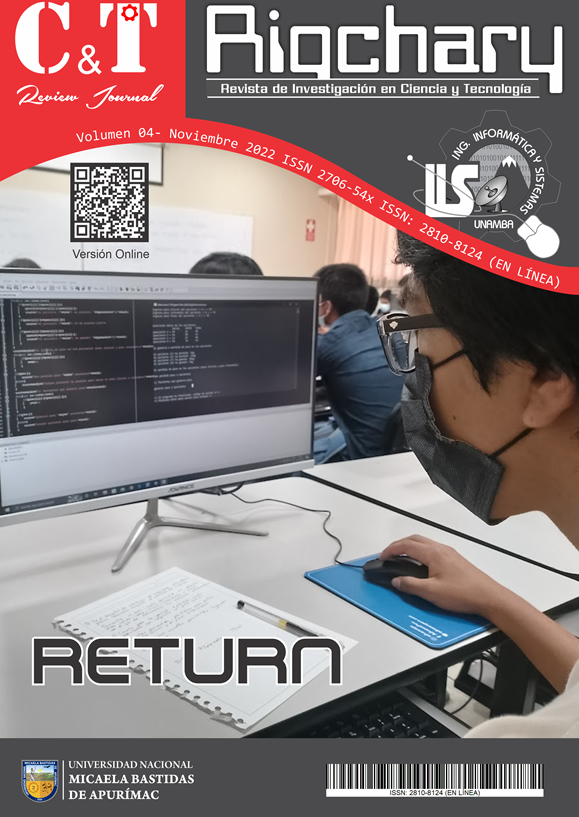Probabilistic methods in discontinuities for the stability of road tunnels and half-tunnels of Karkatera-Abancay
Main Article Content
Abstract
For decades, rock structures were designed based on empirical methods, based on professional experience, support systems tended to be overestimated with the consequent increase in costs, without giving interest to the intrinsic resistance of the rock and applied to Similar cases. The development of the study of Rock Mechanics has reached high levels that have contributed to solving complex problems in rock masses of varied geomechanical conditions, allowing the construction of extensive works in low resistance massifs such as long underground tunnels, underground constructions, food pantries. , underground shelters among others, to take advantage of underground space, especially in countries with high population density. The objective in the Road Tunnels is to seek adequate support for their stability, through a probabilistic study. In the excavation of the Karkatera tunnels, the use of dosed explosives allowed the works to be carried out in a short time, an attempt was made to cause the least damage to the surrounding rock masses with regular and controlled cuts that reduced the need for reinforcements, but even so The rock mass has its behavior governed by discontinuities characterized by conditions such as orientation, persistence, spacing, roughness, etc. that define the degree of fracturing of the rock mass and its resistance to cutting. The present investigation studied the geometric parameters of the families of discontinuities using probabilistic methods to evaluate the probability of rupture of the structures in these civil works with positive results, which allows proposing adequate stabilization methods.
Article Details

This work is licensed under a Creative Commons Attribution-NonCommercial-NoDerivatives 4.0 International License.
When an author creates an article and publishes it in a journal, the copyright passes to the journal as part of the publishing agreement. Therefore, the journal becomes the owner of the rights to reproduce, distribute and sell the article. The author retains some rights, such as the right to be recognized as the creator of the article and the right to use the article for his or her own scholarly or research purposes, unless otherwise agreed in the publication agreement.
How to Cite
References
P. Giani, Rock Slope Stability Anlysis, Rotterdam: CRC Press, 1 Edition 361 p, 1992.
Dusseault,M. y Franklin, J., Rock Engineering, USA: Ed. McGraw-Hill, 1989.
BArton, Lien, R & Lunde, J, Engineering Classification of Rock Masses for the Design of Tunnel Support. Rock Mechanics and Rock Engineering, Norway: Norwegian Geotechnical Institute Oslo 8, 1974.
E. Goodman, Introduccion to Rock Mechanics., New York USA: Jhon Wiley &Sons, 1989, p. 251.
E. Hoek y C. Carranza-Torres, «El Criterio de rotura de Hoek-Brown,» Ingeo Tuneles, Madrid España, 2004.
B. Hidalgo, «Ingenierìa de Rocas en el tùnel de conducciòn.,» Bol Ciencias de la tierra, Colombia, 2002.
V. Terzaghi, «The 23rd U.S SYmposium on Rock Mechanics (USRMS),» Berkeley, California USA, 1946.
N. Barton, D. R. Lien y J. & Lunde, «Estimation of support requirements for underground excavation.,» In HUSTRULID, W, New York USA, 1982.
T. Bieniawski, «Rock Mass classification as a design aid in tunneling. Tunnels and Tunneling,» Mining and Mineral Resources Institute, Pensylvania, USA, 1986.
Ang, Alfredo, H:S: & Tang, WIlson, «Probabiliity Concepts in Engineering Plannig and Design: BAsic Principles,» Jhon WIley &Sons, New York USA, 1975.
Hammersley, M. & Handscomb, C, «Monte Carlo Methods,» Editt Methuem & Co., Ltd, London, 1964.
Kottegoda, T & ROSSO, Renzo, «Statistics,Probability and Reliability for Civil and Environmental Engineers,» Mc Graw-Hill, New York USA, 1997.
Hahn, J. & Shapiro, S. , «Statiscal Models in Engineering,» Edit Jhon Wiley & Sons, Nueva Jersey, USA, 1967.
A. Lionco, «Behaviour of deep shafts in rock considering nonlinear elastic models,» University of Brasilia, Departament of Civil an Environmental Engineering 70910, Brasilia, DF Brasil, 1999.
Carnero, T. y Fujimura, F, «Mecánica de Rochas Aplicada ao Dimensionamiento do Sistema de Atirantamento em Minas Subterráneas. Disertaçao de Mestrado,» Sao Paolo, EPUSP, Brasil, 1995.
A. Lauro, «Análise da Interação Maciço-Suporte em Túneis Escavados em Rocha,» Disertacion de Maestria Universidad de Brasilia, Brasil, 2001.
C. A:, «Métodos Probabilísticos Aplicados à Estabilidade de Taludes e Cavidades em Rocha.,» Dpto. de Engenharia Civil e Ambiental Faculta de Tenologìa, Brasil, 2003.
H. Jaramillo, «Nuevas Tècnicas geofìsicas Aplicadas en Ingenierìa Geotècnica,» Colegio de Ingenieros Civiles de Mèxico, CDMZ Mèxico, 2017.
J. Romero, «Compromise Solutions in Mining Method Selection - Case Study in Colombian Coal Mining. Escuela de Ciencias Exactas e Ingeniería,» Escuela de Ciencias Exactas e Ingenierìa Universidad Sergio Arboleda, Bogotà - Colombia, 2012.
Ramirez, P. y Alejao, L., «Mecánica de rocas, Fundamentos en Ingeniería de Taludes. Máster Internacional “Aprovechamiento Sostenible de los recursos Minerales”,» Universidad Politècnica de MAdrid, España, 2008.
M. Garrido, «Evaluación del coeficiente de seguridad del sostenimiento de galerías y túneles en función de su rigidez,» ETSI Universidad Politècnica de Madrid, España, 2003.
Ferrer, M. & Gonzàles de Vallejo, L., «Manual de campo para la descripción y caracterización de macizos rocosos en afloramientos,» Instituto Geològico de España, MAdrid - España, 2007.
H. Laughlin, «The Geology and Physiography of the Peruvian Cordillera departments of Junín and Lima,» Geoligical Society of America Bulletin, Lima Peru, 1924.
R. Morocco, «Geología de los cuadrángulos de Andahuaylas, Abancay y Cotabambas,» Instituto de Geologìa y Minerìa, Lima Perù, 1975.





